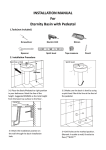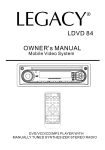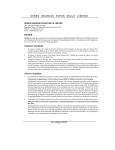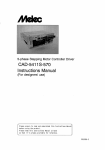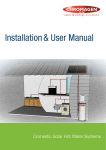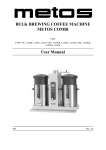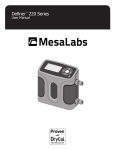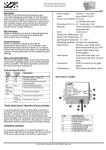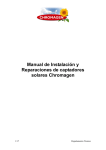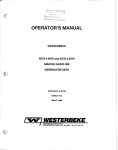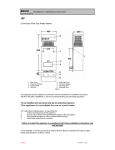Download Service Manual
Transcript
Service Manual SUMO Commercial Hot Water Systems 1 IMPORTANT INFORMATION AND WARNINGS DANGER: Failure to operate the relief valve easing gear at least once every six months may result in the water heater exploding. Continuous leaking of water from the valve may indicate a problem with the water heater. || The power supply must be protected by an individual circuit breaker at the main electrical supply switchboard and rated to suit the booster size. || The supply to the solar water heater can be operated directly from the switchboard or via a remounted switch or time clock as requested by the customer. || The heater must be provided with a suitable means for disconnecting the power supply. || Appliance not intended for use by persons (including children) with reduced physical, sensory or mental capabilities, or lack of experience and knowledge that prevents them from using the appliance safely without supervision or instruction. || Children should be supervised by a person responsible for their safety to ensure that they do not play with the appliance. || The Installation must comply with the requirements of AS/NZS 3500.4 & AS/NZS 3000, and all local codes and regulatory authority requirements. In New Zealand, the installation must conform to the New Zealand Building Code G12 Use of this Manual The SUMO Commercial Hot Water Systems Service Manual is designed to give commercial and installing plumbers aid in the diagnosis of system problems and instruction in the repair of system components. Please read this manual carefully and in full, so that you understand how to trouble shoot a SUMO system and to ensure timely maintenance and service. If you have any questions regarding the installation process, please contact your Chromagen Commercial Solutions representative on 1300 367 565. Other Chromagen Commercial Solutions technical references for SUMO systems: || Hydraulic Manual || Installation Manual || Operation Manual Specifications are subject to change without notice. Images are for illustrative purposes only. Index 1 Standards References4 2 Installation and Commissioning Instructions 8 3 Servicing Safety Devices and Anodes 12 4 T-Series Eternity Gas Booster16 5 The A419 Control Thermostat 22 6 Grundfoss UPS Series Pumps and Screen Filters 30 7 Kanitti Solar Controller34 8 Trouble Shooting and Warranty38 3 1.0 Standards References AS/NZS 3500.4:2003 || Details the minimum standard for installation, alteration or repair of domestic hot water systems. || States the requirements of minimum storage temperature and maximum delivery temperature for hot water systems as follows: Clause 1.9 Water Temperature 1.9.1 Storage temperature. Hot water shall be stored at a minimum of 60°C to inhibit the growth of legionella bacteria. 1.9.2 Sanitary fixtures delivery temperature. All new hot water installations shall, at the outlet of all sanitary fixtures used primarily for personal hygiene purposes deliver hot water not exceeding: || 45°C for early childhood centres, primary and secondary schools and nursing homes or similar facilities for young, aged, sick or disabled persons; || 50°C in all other buildings. NOTE: Compliance with these temperature limits is optional for kitchen sinks and laundry tubs. Individual States or bodies may have their own requirements in addition to, or In excess of, above, this is the minimum requirements under the standards. To meet this requirement Chromagen commercial hot water heaters are set to a higher temperature and a tempering or thermostatic mixing valve must be fitted for fitted for warm water delivery to these areas. Various State Authorities have their own requirements for the provision of water to areas used primarily for personal hygiene. Consult your local authority for any specific requirements in the State or area where the system is to be installed. AS/NZS 3498:2009 || States that means shall be provided to inhibit the growth of Legionella bacteria in potable water within the water-heating appliance. A water-heating appliance will be deemed to comply with this requirement if it satisfies the following requirement: The water heater is operated such that all water is subjected to a temperature dependent minimum exposure period as specified in Table below within 7 days before passing through the water-heating appliance’s heated water outlet. Standards References Table 1 Minimum exposure period 6 Temperatures Minimum exposure period 70°C or greater 1 second 66°C 2 minutes 60°C 32 minutes 55°C 6 hours 7 2.0 Installation and Commissioning Instructions Pre-install || Installation should only be performed by suitably licensed persons in accordance with AS/NZS 3500, AS/NZS 3000, AS/NZS 5601 and applicable local regulations. || Minimum and maximum pressures for gas and water must be observed. || Gas pressure range for optimal operation between 1.13 – 2.75kPa (NG); 2.75 – 3.5kPa (LPG) || Basic manifolding principles must be followed with water coming in one side of the manifold and exiting from the opposite side, this allows for even flow of water through the system and ensures all gas water heaters share the load. Cold Water Supply || The COLD inlet of the tank requires valves to comply with AS/NZS 3500 and local regulations. || The inlet pressure should be 500 kPa for maximum performance. || A Pressure Limiting Valve must be fitted if the cold water inlet pressure is in excess of 500 kPa. Hot Water Outlet || The HOT water outlet pipe is a 32mm BSPT fitting on upper top of the storage tank. Isolation valves are required. || Insulation/lagging must be fitted to all hot water piping to minimise heat loss. Building Return Pump || Secondary or building return pumps may be installed in Eternity Plus & SUMO Pack systems. || Check valves must be fitted on the discharge. || The return line from the building hot water supply loop is connected back to the cold water supply pipe after the check valve. Gas Supply || Check gas type of the Eternity unit’s gas supply available on job (LPG or Natural). || The gas inlet is clearly marked on system. || Gas isolation valves are installed for each gas water heater. || Ensure the gas pipe sizing is adequate to deliver the required volume and pressure. || Refer to the pipe sizing charts in Appendix "F" AS/NZS 5601 for appropriate sized gas pipe. || Purge the gas pipe to ensure removal of debris prior to final connection. || Check for gas leaks Installation and Commissioning Instructions Commissioning Instruction 10 || All power to the system must remain off until the tank and water heater are completely full of water. || Purge the water inlet pipe to remove any debris before final connection to cold water inlet on SUMO pack system. || Turn on the hot water tap to allow air to be removed while tank is filling with cold water, do not bleed with PTR || Gently open the cold water valve on cold water supply. || Once tank is full, turn off the hot water tap. || Check all connections for water leakage. Tighten as required. || Purge gas lines until gas is available at all water heaters. || When the tank is filled, the primary circulation pump must be bled. Unscrew the silver bleed screw on the side of the pump housing, allowing a few drops of water to escape and then tighten. Also ensure the speed switch on the pump is set to 3. Start-up Instructions || Turn on all power to SUMO Pack (GPOs). || Green light on thermostat will illuminate when power is available. || When water in tank is below set temperature 65°C primary circulation pump should start. Water flow will cause gas water heaters to start. || The output water temperature of gas water heater must be higher than the thermostat set point. || Thermostat will display temperature of water in tank. When it reaches the 65°C set point the pump and gas water heaters will stop. The light on thermostat will not be lit when not operating. || Stabilised water and gas pressures must be recorded in the Maintenance log at the rear of this book. NOTE: A commissioning checklist can be found in the Chromagen Commercial Solutions Service Manual for SUMO Commercial Hot Water Systems. 11 3.0 Servicing Safety Devices and Anodes Safety Devices This hot water system is supplied with various safety devices including, Pressure & Temperature Relief Valves (PTR), Consolidated Safety Valve, temperature sensors and overheat sensors. These devices must not be removed, obstructed or tampered with in any way that may affect the operation of the safety device. These devices must be installed as required and be tested at the time of commissioning and under a regular maintenance program to ensure safe operation of the system. Pressure Temperature Relief Valve (PTR) This valve is located at the top of each tank. It is normal for a small amount of water to be discharged. Your system is fitted with a 1000kPa PTR, please ensure that the water pressure is maintained at a maximum of 80% of this value to minimise excessive water discharge. It is recommended that the easing lever be actuated every six months to prevent the accumulation of mineral deposits that may impair valve operation. The easing lever should be operated smoothly as a sudden influx of water may damage the valve. The drain line must be compliant with AS3500 Consolidated Safety Valve (If fitted) A consolidated safety valve may be fitted to the primary tank. This device is designed to release any steam that may form during sudden pressure drops within the system. This valve should be inspected regularly and maintained in accordance with the valve manufacturers recommendations. Expansion Control Valve (If fitted) An expansion control valve may be fitted in the cold water supply line to the water heater, it may discharge a small quantity of water instead of the PTR valve on the water heater. The benefit is that energy is conserved as discharged water is cooler. If this leaks continuously it can indicate high pressure in the tank and may require a pressure limiting valve to be fitted. Anode replacement Servicing Safety Devices and Anodes The anode in the Chromagen hot water tanks is located on the flange plate assembly at the top of the tank. To inspect or replace the anode: 1. Disconnect water supply and remove pressure 14 2. Open PTR to ensure pressure is relieved 3. Remove covering cap at top of tank 4. Unbolt top flange plate, removing all flange and lifting bolts 5. Remove flange 6. Replace anode if required 7. Inspect tank seal and replace if required 8. Re-install flange in reverse order as described above 9. Test for leaks Flange bolt Anode bolt Lifting bolt Flange plate Electric Element & Thermostat (if present) Ensure power is turned on and available to the thermostat. Check thermostat for thermal overload, test rest and inspect for cause of potential electrical overload. If power is present and can be measured across output terminals of thermostat, measure resistance of element to determine possible source of fault. Replacement of electric element: 1. Disconnect power from system 2. Disconnect water supply and remove pressure 3. Open PTR to ensure pressure is relieved 4. Remove covering cap at top of tank 5. Unbolt top flange plate, removing all flange and lifting bolts 6. Remove flange 7. Replace element if required 8. Inspect tank seal and replace if required 9. Re-install flange in reverse order as described above 10.Test for leaks Thermostat testing 1. Disconnect power from system 2. Turn red dial up/down until click of bi-metallic strip is heard 3. At point of click measure temperature 4. Measure tank temperature 5. If tank temperature and thermostat temperature do not correspond calibration may be required, otherwise jump to step 10 6. Remove black plastic cap from thermostat 7. Using brass spline shaft adjust to point of activation of the metallic strip (clicking) 8. Set red dial on black cover to temperature of system 9. Refit black cover 10.Test to ensure click occurs at point of corresponding temperature 11.Disconnect element and turn thermostat to minimum 12.Measure resistance terminals 1-3 should be short circuit 13.Measure resistance terminals 2-4 should be short circuit 14.Reconnect element 15.Reconnect power 16.Test operation 17.Disconnect power and replace thermostat if required 15 4.0 T-Series Eternity Gas Booster Figure 1. Eternity T-Series Parts Table 2 Parts list T-Series Eternity Gas Booster No. Description 18 No. Description No. Description 1 Front Panel 11 Thermal Fuse Device 23 Water Control Valve 2 Outer Casing 12 Combustion Chamber 24 Remaining Flame Safety De. 3 Exhaust Flue 13 Fan Motor Assembly 25 Manifold 4 Modulation Valve Unit 14 Burner Assembly 26 Drain Knob 5 P.C.B. Unit Assembly 15 Cable Access 27 Ignition Spark Electrode 6 Igniter 16 Frost Sensing Switch 28 Flame Sense Electrode 7 Incoming Water Temp. Thermistor 17 Water Flow Sensor 29 Transformer (240V) 18 Heat Exchanger 8 Water Inlet 19 Gas Inlet 9 Hot Water Outlet 20 Exhaust Chamber 10 Outgoing Water Temp. Thermistor 21 Pressure Relief Valve 22 Anti-frost Heater Figure 2. Eternity T-26 Block diagram 19 Figure 3. Eternity T-Series Wiring diagram Takagi dip switch setting pattern DIP SWITCH PATTERN T-Series Eternity Gas Booster 7 8 60°C 75°C H 45°C ON ON OFF 55°C OFF OFF OFF 60°C ON OFF OFF 75°C OFF ON OFF 80°C - - ON PATTERN 20 6 DIP SWITCH 1 2 LPG ON OFF NATURAL OFF ON 3 4 ON OFF Table 3 and 4 Eternity T-Series wiring information Check Point Mark on Electric Diagram Normal Range Colour/Number of Wire A Light blue(3) - blue at COM DC80 ~100V / 0.8~1.7kΩ A green(9) DC80 ~100V A orange(53) - blue at COM DC80~100V A red(73) DC80~100V A1 blue - blue DC1V & less / 1.3Ω & less A2 blue - blue DC1V & less / 1Ω & less B red - blue DC110~160V B yellow - blue DC110~160V B orange - blue DC2~6.5V B white - blue DC3~12V (4000Pulse/min & more) C1. C2 black - black 10°C12~18kΩ 60°C2.2~2.7kΩ D red(+) - black(-) DC4.0~5.5V D white(85) - black(-) DC1~4V (1080Pulse/min) E white - black DC11~25V F red - black DC7~16V / 0.09~0.2kΩ G white - red DC1~10V / 30~51Ω H orange(17) - green(18) DC -10~100V H yellow - green(18) DC -0.2~ -5V I purple(7) - purplt(7) AC90~110V J white - black AC90~110V - blue at COM - blue at COM Light of LED on Main P.C.B. Remote Control Fault Possible region of error Blinking One time 031 Fault of Gas Selection Switch Gas Selection Switch 701 Fault of PCB Main PCB Fault of loading circuit on PCB for Proprtional valve Proprtional valve 311 Disconnection/Short circuit of Hot water outlet Thermistor Hot water outlet Thermistor 321 Disconnection/Short circuit of Cold water inlet Thermistor Cold water inlet Thermistor Blinking Two times 391 Fault of Air-fuel Ratio Rod Air-fuel Ratio Rod CL Continue to opened the tap Bath fill switch 111 Fault of Ignition Main PCB, Igniter, Flame rod, Thermal fuse, Remaining Flame Safety Device 121 Lost of Flame Solenoid or other part of Gas circuit 510 Fault of drive circuit for Main Solenoid Main Solenoid , Main PCB 511 Fault of drive circuit for Solenoid Valves Solenoid Valves, Main PCB 721 Fault of Pre-check Main PCB, Flame rod 991 Imperfect Combustion Exhaust flue, Air inlet, Test point gas pressure, Heat Exchanger Blinking Four times 611 Irregular fan speed Fan motor or Main PCB Blinking Five times 101 Warning for 991 Error Code Exhaust flue, Air inlet, Test point gas pressure, Heat Exchanger Blinking Three times 21 5.0 The A419 Control Thermostat The Johnson A419 control is a Single-Pole, Double-Throw output relay. The control features a lockable three button touch pad for set-up and adjustment, and a liquid crystal display (LCD) which displays the sensed temperature and other control functions. A front panel light emitting diode, (L.E.D.) indicates the output relay status. When the relay contact is energized and the thermostat contacts close, the LED will be illuminated. The control fitted to the SUMO cylinder is factory set to a set point temperature of 65°C, unless an alternative temperature has been specified for a specific job. When the power is turned on to the thermostat, the digital display should scroll through and settle on the temperature reading of the water within the storage cylinder. As water is heated, the display temperature will increase to indicate current temperature of water within the cylinder. Set-point (SP) The set-point establishes the temperature value at which the equipment will be switched on or off, depending on the user selected mode of operation. Set-point range can be set from -34 to 100°C, in one degree increments. The set-point mode in Chromagen systems is set to cut-out, the set-point is the temperature at which the (N.O.) contacts will open. For the SUMO, this cut out set-point is normally 65°C. Differential (diF) The differential establishes the difference in temperature between the cut in value and the cut out value. The difference is set relative to the set-point and may be between 1°C to 30°C. For the SUMO, this setting is the same as the factory default setting of 4°C. Anti-Short Cycle Delay. (ASD) The Anti-Short Cycle Delay establishes the minimum time that the output relay remains deenergized before the next on-cycle. The ASD does not allow the output relay to re-energize until the programmed time delay has elapsed. The delay is activated when the control is first turned on and every time an on cycle ends. When the display is activated, the LCD alternatively flashes the sensor temperature and the ASD. The ASD range is 0 to 12 minutes in one minute increments. For the Chromagen systems, the ASD setting is 0 minutes. Temperature Offset (OFS) The OFS establishes a set secondary Set-point and Differential values that may be invoked to The A419 Control Thermostat control an application where the circuit is closed between the Binary input (BIN) and Common (COM) terminals ( and BIN appears on the display) Offset range is 0°C to 50°C (in one degree increments). A typical application might use a switching time clock to involve night-setback temperature settings. For the Chromagen systems, this function is not utilized. 24 Settings & Adjustments The Johnson A419 Temperature Controller is ‘locked‘ at Chromagen to a set temperature. Adjusting the UP & DOWN buttons will have no effect on the thermostat. On normal servicing & fault finding, there is no need to adjust the thermostat. If ordering a new/replacement Johnson A419 temperature control as a spare part, the control will need to be correctly set to suit the SUMO system. The touchpad cannot be unlocked without a jumper installed across the P5 jumper pins. Do not discard jumpers in case they are required in the future Positioning the Jumpers || The P5 jumper position determines if the touchpad is locked or unlocked. || The P4 jumper pin block has two pairs of jumper pins. The top pair of pins (JUMP1), determines if the control is set for heating or cooling mode. The bottom pair of pins, (JUMP2) establishes whether set point is at cut in or cut out. NOTE: Make sure the Touchpad Lock jumper is installed (Unlocked) before attempting to adjust Touchpad Touchpad Heatingthe Mode Locked A419 control functions. Figure 4. Positioning the Jumpers Unlocked Cut-in at Setpoint Figure 5. Jumper Positions & Control Settings Cooling Mode Cut-in at Setpoint JUMP1 JUMP2 = Jumper Installed (Jumper Positioned on Both Pins) P5 P4 Touchpad Touchpad Locked Unlocked = Pins Jumper JUMP1 = Removed (Jumper Positioned on One Pin) Installed (Jumper Positioned on Both Pins) P5 JUMP2 P4 Cooling Mode Cut-in at Setpoint Cooling Mode (Standard) Cut-out at Setpoint Heating Mode (Standard) Cut-out at Setpoint = Pins Heating Mode Cut-in at Setpoint Heating Mode (Standard) Cut-out at Setpoint Cooling Mode (Standard) Cut-out at Setpoint Removed (Jumper Positioned on One Pin) Jumper Designations, Jumper Positions and Control Settings Function Jumper Pins Designation on Control Setting Jumper Position Operating Mode JUMP1 Top pair of pins on Block P4 Heating Mode Installed Set Point JUMP2 Bottom pair of pins on Block P4 Set-point at Cut Out Installed Touch Pad Lock P5 Locked Removed Unlocked Installed 25 Changing the A419 Control Temperature Units || The A419 control is factory set to display Fahrenheit temperature. To change to Celsius, press the two arrow buttons simultaneously. || UP and DOWN arrows simultaneously. || Press UP & DOWN arrows simultaneously again to return to a Fahrenheit temperature. || Verify that the control is displaying the desired temperature units before setting the set-point. Setting the A419 Control Set-Point To view & adjust set-point: || Press and hold MENU (about 2 seconds) until the display flashes ‘SP’ || Press MENU again to display existing set point value. || Press UP or DOWN arrows to change set-point value. (Typically 65°C) || Press MENU again to save new value. The display will now return to the sensed temperature. LCD UP/ DOWN ARROWS LED NOTE: If no set-up entry is made for 30 seconds, the control reverts to (normal) temperature display. Setting the other A419 Control functions The A419 Control Thermostat To set the Differential, Anti sort cycle display, Temperature offset or Sensor failure operation, use the following method: 26 || Press and hold MENU until display changes to flashing ‘SP’. (Normally takes about 2 seconds) || Press UP or DOWN arrows repeatedly until the desired function is displayed. (see table below) || Press MENU to display the functions current value. || Press UP or DOWN arrows until the desired temperature is displayed. || Press MENU to save the new value. The display will then return to the sensor temperature. NOTE: If MENU is not pressed after changing the setting, the new setting will not be saved and the control will revert to the previously programmed setting values. Table 5 Control function displays Display Symbol Function Control Range – Units/Value Range – Units/Value SP Set Point -34 to 100°C diF Differential 1°C to 30°C in 1 degree increments ASd Anti-short cycle 0 to 12 – (in one minute increments) SF Sensor Failure Operation (No range) 0 = output relay de-energised 1 = output relay energised F or C Temperature Units (No range) - °F or °C Flame Symbol Heating Mode Heating (flame symbol) is displayed when JUMP1 jumper is installed NOTE: Do not set the Set-point and Differential values, which (when their values are totaled), fall outside the A419 control’s set-point range (–34°C to 100°C). The control will not function properly if the Cut In or Cut Out values are outside the control set-point range. If no setup entry is made for 30 seconds, the control reverts to the normal temperature display. Any saved A419 control settings are non-volatile and remain in the controller’s memory during power interruptions. CAUTION – RISK OF ELECTRIC SHOCK Hazardous voltages may be present at electrical terminals and other exposed internal metal surfaces. Do not touch any metal parts within the control when cover is removed. Any contact with metal parts including with metal conductive tools may result in serious injury or death. Testing if power is available to thermostat: 1. Remove lower cover panel from storage cylinder 2. Remove the four (4) screws securing the cover of Johnson controls thermostat 3. Carefully lift up cover. Cover is attached by wiring to PCB inside thermostat, so cover cannot be removed, only moved 4. Check for 240 volt power supply on supply terminals located under card cover Testing if power is available to common terminal on thermostat: 1. Check 240VAC power is available on thermostat common terminal Testing if thermostat contacts have closed: 1. Once temperature displayed on thermostat is less than set temperature, check for 240 VAC available on terminal supplying voltage to primary pump and neutral. 2. If contacts have not closed, thermostat is faulty. Replace thermostat Repairs & Replacement Do not attempt to repair or recalibrate the Johnson A419 temperature control. In the case of a defective or improperly functioning control, the control will require replacement. 27 Figure 6. Wiring Diagram for Johnson Controller Common Sensor N A E 240V AC Supply The A419 Control Thermostat GPO 28 Testing to see if temperature probe is working correctly: 1. Disconnect all power sources to the control 2. Remove the lower cover panel from the storage tank 3. Remove four screws from the cover panel on the Johnson controller 4. Carefully lift up cover. Note: cover is attached by wiring to PCB inside thermostat, so the cover cannot be re-moved, only moved to one side. 5. Using a thermometer, take a temperature reading at the sensor location 6. Disconnect sensor from control 7. Check resistance of temperature probe, across the two wires 8. Check measured value conforms to table below 9. If temperature measured resistance value is substantially different from the expected value for that temperature, replace controller assembly (PT no MK0005) Graph 1. Thermostat resistance vs. temperature Temperature ( °F) 260 240 220 200 180 160 140 120 100 80 60 40 20 0 -20 -40 Temperature ( °C) 120 100 80 60 40 20 0 -20 -40 500 700 900 1100 1300 1500 1700 1900 2100 29 6.0 Grundfoss UPS Series Pumps and Screen Filters Grundfoss Pumps Pump orientation Care should be taken to ensure correct orientation of the pump. The control box should be on the upper surface to prevent water entry. Pump speed should be set to speed III (3) and pumps should be regularly used. Failure to circulate water through the pump may result in premature failure and result in the pump seizing due to mineral deposits within the water. Your Chromagen system is designed to ensure the pumps are regularly circulated to avoid this, but disconnection or decommissioning of the system must include draining of the pump assemblies. The pump should always be bled using the screw on the front of the pump motor assembly as seen above. Noises and scraping sounds should be investigated to avoid failure of bearings or impellor mechanism. Bleeding Air from Primary Pump Grundfoss 20-60B & Grundfoss 32-80N: 1. Turn on power supply to pump 2. Make sure the speed selection switch is on 3 3. Unscrew (counter clockwise) end cap in motor 4. Allow air & water to dribble out of bleed hole 5. When all air is bled through, re-place end cap in motor 6. Check for water leaks Check power is available to the primary circulation pump: 1. Plug pump into known good 240V AC supply and test operation. Grundfoss UPS Series Pumps and Screen Filters 2. Free impeller if seized, replace pump if impeller is dislocated from the motor drive shaft. 32 3. Replace pump if required. 4. Ensure pump is correctly primed, prior to use and that all air is bled through. CAUTION If hot water system has been operating, the water being bled from the pump could be very hot. Do not locate the electrical connection & speed selection switch underneath the pump body Maintenance Instructions for Manual Screen Filter The screen filter bodies are fabricated from mild steel, and finished corrosion resistant baked on polyester coating. To install the filter mount the inlet and outlets with the water flow going in the correct direction. A pressure gauge or indicator could be fitted across the inlet and outlet to indicate the condition of the filter. 1 1 - Cover 2 - Body 3 - Outer screen element 4 - Inner screen element 5 - Pressure measuring port 3 2 6 - Flushing valve 4 5 6 To clean the screen element, follow the following sequence: 1. Isolate the filter and de-pressurise any pressure remaining in the system. 2. Unscrew the T-clamp handle and remove the clamp bar from it’s mounting holes. 3. Remove the lid of the filter. 4. Remove the filter element from the filter. 5. Clean the screen element with a pressure hose. 6. With disc elements the clamp nut inside the end of the disc pack needs to be fully loosened to release and expand the discs so that a hose can easily clean the element. 7. Clean the element thoroughly and replace. 8. Reassemble the filter lid and clamp in opposite sequence to disassembly making sure that the end seals are in correct position. Do not over tighten cap! The cleaning frequency of the filter will depend on a number of factors including: The volume of suspended solids in the water, the flow rate, the particle sizes and the aperture of the screen in the filter. Our inline one or two-stage filters are designed for use in agricultural, industrial and public sector/municipal environments, either as control filters or as main filters. Our Manual Screen Filters standard features include: || Inlet/outlet on axis of 90 degrees for type 100 and 180 degrees for type 200 || Inlet and outlet through quick coupling, threaded, or flange connectors electrostatically oven-cured with polyester powder at 150 micron thickness or heat galvanized at 100 micron thickness || Double element filters (optional) available in micron sizes of 60, 80, 100, 120, 140, 155, 200 || Maximum working pressure up to 8 bar (116 psi) 33 7.0 Kanitti Solar Controller Kanitti Solar Controller The Geros Solar Controller operates by measuring the temperature in the tank and Solar Collector and operates when a pre-determined temperature differential is reached. During normal operation when the collector sensor reaches 7 degrees above the tank the pump will turn on to circulate water through the system. No lights on Pump off (collector less than7 degree hotter than tank) no error Green on Pump on (collector greater than 7 degree hotter than tank) no error Red on Pump off (overheat mode, tank temperature above 80 degrees) no error Red & Green on Pump on (Frost mode, collector temperature below 5 degrees) no error Red flashing (slow) Collector sensor open circuit or not connected, check cable Red flashing (fast) Collector sensor short circuit, check cable Green flashing (slow) Tank sensor open circuit or not connected, check cable Green flashing (fast) Tank sensor short circuit, check cable Testing of Controller TANK SENSOR Unplug the red RCA plug and the GREEN LED should flash. COLLECTOR SENSOR Unplug the black RCA plug and the RED LED should flash. PUMP OPERATION Plug pump directly into mains power socket (using extension lead), check for operation. PUMP POWER Plug a small appliance such as a lead light into socket and wait for activation as per normal Solargain. INCORRECT TEMP Check resistance of sensors as per GEROS sensor Service Advice POWER TO UNIT Turn power to controller off, unplug pump, wait 20 seconds then turn power back on and both LED’s should flash then turn off. NOTES: After power interuption, controller may need to be reset, by turning off power, waiting 20 seconds, then turning power back on to initialise system. Kanitti Solar Controller Testing of Sensors 36 Using a Multi-meter sensor resistance should be measured using a multi-meter set to resistance (Ω) mode, temperature measured is as per following table. This table applies for both Tank and Collector sensors. Extension cable testing extension cables can be tested by substituting a known good panel sensor and testing as per above using a multi-meter. There should be very little difference if the extension cable is OK. || Damage to cables is not covered under the warranty terms and conditions, please ensure that all cables are inspected for damage before determining warranty status. || Cables are often damaged during installation as they are pulled through the roof or damaged during contruction of the building. || In over 95% of all cables and sensors received back for assessment the cause was damage to the part. The following table is for representative purposes only and should not be taken as an exact value. Differences in resistance of probes, leads and other variables may alter the reading taken and these should be treated as an approximate value for diagnostic assistance only. Temp Celsius Resistance K-ohms Temp Celsius Resistance K-ohms Temp Celsius Resistance K-ohms Temp Celsius Resistance K-ohms -10°C 37.45 16°C 12.09 42°C 4.57 68°C 1.96 -9°C 35.73 17°C 11.61 43°C 4.41 69°C 1.91 -8°C 34.11 18°C 11.16 44°C 4.26 70°C 1.85 -7°C 32.56 19°C 10.72 45°C 4.12 71°C 1.79 -6°C 31.10 20°C 10.31 46°C 3.98 72°C 1.74 -5°C 29.71 21°C 9.91 47°C 3.85 73°C 1.69 -4°C 28.39 22°C 9.53 48°C 3.72 74°C 1.64 -3°C 27.13 23°C 9.17 49°C 3.60 75°C 1.58 -2°C 25.94 24°C 8.82 50°C 3.48 76°C 1.55 -1°C 24.81 25°C 8.49 51°C 3.37 77°C 1.50 0°C 23.73 26°C 8.17 52°C 3.26 78°C 1.46 1°C 22.71 27°C 7.87 53°C 3.15 79°C 1.42 2°C 21.73 28°C 7.58 54°C 3.05 80°C 1.38 3°C 20.81 29°C 7.30 55°C 2.95 81°C 1.34 4°C 19.92 30°C 7.03 56°C 2.86 82°C 1.30 5°C 19.09 31°C 6.78 57°C 2.77 83°C 1.27 6°C 18.29 32°C 6.53 58°C 2.68 84°C 1.23 7°C 17.52 33°C 6.30 59°C 2.60 85°C 1.20 8°C 16.80 34°C 6.07 60°C 2.52 86°C 1.16 9°C 16.11 35°C 5.86 61°C 2.44 87°C 1.13 10°C 15.45 36°C 5.65 62°C 2.36 88°C 1.10 11°C 14.82 37°C 5.45 63°C 2.29 89°C 1.07 12°C 14.22 38°C 5.26 64°C 2.22 13°C 13.65 39°C 5.08 65°C 2.15 14°C 13.10 40°C 4.90 66°C 2.09 15°C 12.58 41°C 4.73 67°C 2.02 37 8.0 Trouble Shooting and Warranty Trouble Shooting your Hot Water System Before you request a service call please use the following table to identify the fault and remedy. Table 6 Fault Check & Remedy Trouble Shooting and Warranty Thermostat fails to turn on Check power is available to the thermostat and digital temperature display pump on the thermostat LCD is lit. Check thermostat reading is less than the thermostat start up temperature (normally 60°C). Check thermostat contacts have closed (refer components test sheet). 40 Thermostat displays temperature in Fahrenheit in-stead of Celsius Unit has reset to default due to power surge, hold both ^ V buttons to change to Celsius. Primary pump starts and water flows, but booster fails to start up Check power is available to booster and reset power. Check inlet water filter to booster is clean and free from debris. Check there is no airlock within the primary pump. Bleed air from pump. Check pump installation, flow direction may be incorrect. Refer to booster service manual for booster fault finding. Primary pump starts booster starts and then booster stops. Check incoming, operating gas pressure is sufficient (Natural Gas -1.13kPa & Propane - 2.75kPa). Refer to booster service manual for booster fault finding. Thermostat activates but the pump does not start Check the Primary circulation pump is plugged into the thermostat GPO and switched on. Check thermostat contacts have closed (refer components test sheet). Check for 240V ac power available at the pump (refer components test sheet). Plug pump into known good power socket. Primary pump starts but there is no water flow Check isolation ball valves in the pump connections are turned to the open position. Screwdriver slots should be aligned along pipe for ‘open’ position Check pump has been installed with correct direction of water flow. Check pump impeller is spinning and not jammed or broken. Water temperature taking excessive time to recover. Check water inlet filters on booster/s are clean and free from debris. Check all eternities are operating. Ensure pump speed is set to 3 (maximum). Check dipswitch settings on eternities to ensure correct temperature is selected. (Eternity units are normally set to 70°C and storage tank thermostat set to 65°C) Ensure operating gas pressure is adequate (Natural Gas -1.13kPa & Propane - 2.75kPa) Check there is not excessive hot water being drawn off. Noise in Primary pump Check all air has been bled from the pump. Check for worn bearings and foreign objects. Replace pump/damaged impellor. Excessive time taken for hot water to reach hot water outlet Check length of pipe between storage tank and hot water outlet. Building circulation pump maybe inadequate. Check power is available on the building circulation pump. Check pump is not turned off via a incorrectly set time clock on building circulation. Check building secondary circulation pump is operating correctly. (i.e. No airlocks or seized impellers) Water leaking from temperature and pressure relief valve Check incoming cold water pressure does not exceed 800kPa or 80% of PTR valve rating. When a PTR valve (800kPa) is fitted on cold water inlet, cold water pressure is not to exceed 80% of valve setting (600kPa) . Check water temperature does not exceed 95°C If pressure and temperature are correct, replace PTR valve. Johnson A419 Control Thermostat Error Codes and Trouble Shooting Table 7 Error code Definition System Status Solution SF Flashing alternatively with OP Open circuit temperature sensor or sensor wiring Output functions according to the selected sensor failure mode (SF Setting) Check sensor cable for damage and cycle power to reset the control SF Flashing alternatively with SH Short circuited temperature sensor or sensor wiring Output functions according to the selected sensor failure mode (SF setting) Check sensor cable for damage and cycle power to reset the control EE Program failure Output is off Reset the control by pressing the menu button. If the problem persists, replace the controller Warranty table Product Commercial Warranty HOT WATER Eternity (Heat exchanger) 5 Years Tanks (Enamel) 5 Years Flat Plate Solar Collectors 7 Years Evacuated Tube Solar Collectors 1 Year Circulation Pumps 1 Year All other parts & Labour 1 Year Chromagen shall provide both the labour and the parts required to repair, or, at Chromagen's option, Chromagen shall replace any part of the system which upon examination by Chromagen is determined by Chromagen to have been defective during the applicable warranty period. The replacement component shall carry the balance of the original warranty period. The water heater must be installed in accordance with Chromagen's installation instructions along with relevant local and statutory requirements. Damage to buildings, chattels or any other consequential damage caused either directly or indirectly due to leakage of the water heater and breakage of collector glass due to vandalism or storms including hail are not within the scope of this warranty. For full details of our Terms and Conditions please refer to the Chromagen website at chromagen.com.au. 41 Notes: ____________________________________ ____________________________________ ____________________________________ ____________________________________ ____________________________________ ____________________________________ ____________________________________ ____________________________________ ____________________________________ ____________________________________ ____________________________________ ____________________________________ ____________________________________ ____________________________________ ____________________________________ ____________________________________ ____________________________________ ____________________________________ ____________________________________ ____________________________________ ____________________________________ ____________________________________ Notes: ____________________________________ ____________________________________ ____________________________________ ____________________________________ ____________________________________ ____________________________________ ____________________________________ ____________________________________ ____________________________________ ____________________________________ ____________________________________ ____________________________________ ____________________________________ ____________________________________ ____________________________________ ____________________________________ ____________________________________ ____________________________________ ____________________________________ ____________________________________ ____________________________________ ____________________________________ CNF0068 032012 Chromagen Pty Ltd | chromagen.com.au | [email protected] | 1300 367 565 VICTORIA | NEW SOUTH WALES | QUEENSLAND | NORTHERN TERRITORY | WESTERN AUSTRALIA | SOUTH AUSTRALIA












































